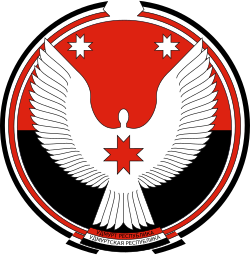
Aq Bars is the emblem of Tatarstan. It is an ancient Bulgar symbol translated as "White Leopard" or "Snow Leopard", and has been in use since 1991 as the official symbol of Tatarstan.

The coat of arms of Dagestan was instituted on 20 October 1994. The eagle is a traditional symbol of nobility, courage, wisdom, and faith.

The coat of arms of the Russian Republic of Karelia is crossed in three equal parts with the colors of the flag of Karelia on a shield with a profile of a rampant black bear. The golden frame of the shield comes into stylized image of a fir tree on the left and a pine tree on the right. In the upper part of the shield there is an octagonal star of gold. The arms were created by Yu. S. Nivin.

The coat of arms of Ingushetia was instituted on August 26, 1994. In the center of the circle is an eagle and a battle tower. In the background is Stolovaya mountain ("Matloam") on the left of the tower and Kazbek mountain ("Bashloam") on the right. Above the tower a yellow sun is shining in blue sky.
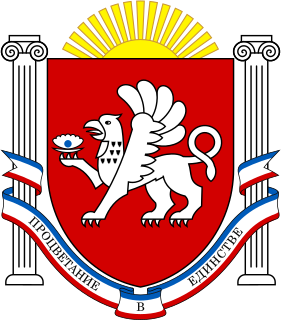
Both the Ukrainian Autonomous Republic of Crimea and the Russian Republic of Crimea use the same coat of arms, which has been in use since 1992.

The coat of arms of Moscow depicts a horseman with a spear in his hand slaying a basilisk and is identified with Saint George and the Dragon. The heraldic emblem of Moscow has been an integral part of the coat of arms of Russia since the 16th century.

The coat of arms of the Komi Republic, designed by A. Neverov, was instituted by the law No. XII-20/1 on June 6, 1994 and reflects the mythic beliefs of the Komi peoples. The blazon has a field gules, featuring a bird of prey or with the face below corresponding with goddess Zarni An, and six unhorned elk heads. On December 17, 1997 the Republican State Council passed the law, which changed the official coat of arms definition in order to agree with the rules of heraldry.

The coat of arms of the Republic of Adygea, a federal subject of Russia, was adopted on May 24, 1994. It is registered as №163 in the Heraldic Register of the Russian Federation.

The coat of arms of the Jewish Autonomous Oblast in the Russian Far East has the figure of a Amur tiger turned to the right toward a viewer, which symbolises the unusual history and development of the Oblast. The aquamarine background represents the colour of the vast Far Eastern taiga, hills, and meadows in the region.

The emblem of Tuva is a light blue field with a yellow border. In the center of the field is a traditional horseman, symbolizing Tuva's sovereignty and spirit. The coat of arms was created in 1992, and is similar to the present state emblem of Mongolia, which was adopted that same year.

The coat of arms of the Republic of Kalmykia is a symbol of the Republic of Kalmykia, a federal subject of Russia. It was adopted by the republic's Parliament on June 14, 1996. It is registered in the State Heraldic Register of the Russian Federation.

Coat of arms of Novosibirsk Oblast is the principal official symbol of Novosibirsk Oblast, Russia.

The coat of arms of the Republic of Buryatia is one of the official symbols of the Republic of Buryatia—a federal subject of Russia. It was adopted on 20 April 1995.
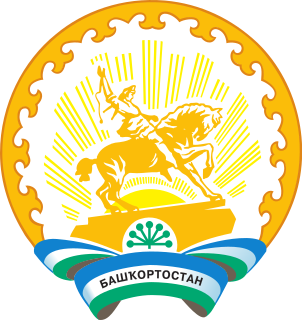
The coat of arms of Bashkortostan is a national symbol of the Republic of Bashkortostan, Russia.
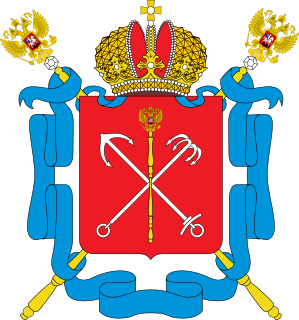
The coat of arms of Saint Petersburg is the official symbol of the city and was adopted in 23 April 2003.

The coat of arms of the Bryansk Oblast was approved by the Bryansk Oblast Duma on November 5, 1998. According to the official description provided by the legislature of the oblast, the arms of the Bryansk Oblast "reflect the characteristic features of the area and its inhabitants: industry and patriotism.
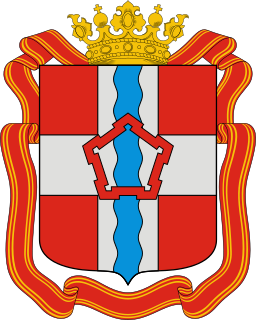
The coat of arms is a symbol of the Omsk Oblast, Russia adopted 29 May 2003. Its authors are Igor Vahitov, Albert Karimov and Oleg Nikitin.

The coat of arms of the Chechen Republic is the official symbol of the Chechen Republic. Approved by acting President of Chechnya Sergey Abramov on 22 June 2004.

The coat of arms of the Sakha Republic, in the Russian Federation, is an official symbol of the Sakha Republic, alongside the flag and the national anthem of the Sakha Republic. The coat of arms consists of a circle, in the center of which is a red silhouette of a rider, holding a banner, mounted upon a six-legged horse, based on the prehistoric petroglyphs of the "Shishkin pisanitsa", against a white sun background. The central image is framed with a traditional Sakha ornament in the form of seven rhombic crystal-like figures and the inscriptions "Республика Саха (Якутия) • Саха Өрөспүүбүлүкэтэ". This coat of arms has been used officially since 26 December 1992.
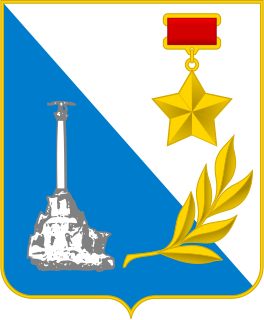
The coat of arms of Sevastopol is a heraldic symbol representing the city of Sevastopol, Crimea. It is featured in the middle of the Flag of Sevastopol on a red background.
This page is based on this
Wikipedia article Text is available under the
CC BY-SA 4.0 license; additional terms may apply.
Images, videos and audio are available under their respective licenses.
